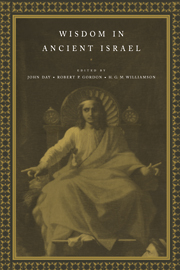Book contents
- Frontmatter
- Contents
- List of abbreviations
- Introduction
- Part 1 The ancient near eastern setting
- Part 2 Old Testament and Apocryphal texts
- Part 3 Themes
- 17 Were there schools in ancient Israel?
- 18 The trees, the beasts and the birds: fables, parables and allegories in the Old Testament
- 19 The personification of Wisdom
- 20 Wisdom and the goddess
- 21 Wisdom at Qumran
- 22 The interpretation of wisdom in nineteenth-century scholarship
- 23 Wisdom and Old Testament theology
- Biographical note: John Adney Emerton
- Bibliography of the works of John Adney Emerton
- Indexes
- Principal biblical and apocryphal references
20 - Wisdom and the goddess
Published online by Cambridge University Press: 16 October 2009
- Frontmatter
- Contents
- List of abbreviations
- Introduction
- Part 1 The ancient near eastern setting
- Part 2 Old Testament and Apocryphal texts
- Part 3 Themes
- 17 Were there schools in ancient Israel?
- 18 The trees, the beasts and the birds: fables, parables and allegories in the Old Testament
- 19 The personification of Wisdom
- 20 Wisdom and the goddess
- 21 Wisdom at Qumran
- 22 The interpretation of wisdom in nineteenth-century scholarship
- 23 Wisdom and Old Testament theology
- Biographical note: John Adney Emerton
- Bibliography of the works of John Adney Emerton
- Indexes
- Principal biblical and apocryphal references
Summary
It is fitting that this article should be included in a volume in honour of Professor J. A. Emerton, for it was he who first opened my eyes in wisdom to the study of Semitic goddesses. The personification of Wisdom as a woman in the book of Proverbs as well as in the deutero-canonical books of Sirach, Baruch and the Wisdom of Solomon has been much discussed, and is the topic of another chapter in this volume. This chapter will consider Lady Wisdom (or Israelite hokmâ), and will examine whether or not this personification of Lady Wisdom refers to an actual person (divinity or hypostasis) or is merely a literary device.
Since W. F. Albright advocated a Canaanite background to Proverbs, scholars have considered the possibility of a goddess being the inspiration for the figure of Lady Wisdom (or, in the case of G. Boström, Lady Folly). In recent years, perhaps the most vocal advocate of the connection between Wisdom and a goddess has been Bernhard Lang. The main texts which appear to give divine status to Lady Wisdom are Prov. i, viii and ix; Job xxviii (although Wisdom is not explicitly personified here); Ecclus i 1–10 and xxiv 1–22; Baruch iii 9–iv 4; and Wisd. vii–ix, although other more isolated passages in Prov. i–ix, Ecclesiasticus and Wisdom also appear to give Lady Wisdom divine status. The consensus is that these texts in their present form are all relatively late, although the dating of Prov. i–ix and Job xxviii is disputed (see below).
- Type
- Chapter
- Information
- Wisdom in Ancient Israel , pp. 234 - 243Publisher: Cambridge University PressPrint publication year: 1995
- 4
- Cited by



